Documents: Go to download!
- Owner's manual - (English, French)
- Getting Started
- Loading the Dishwasher
- Detergent
- Dishwasher Cycle Options
- Operating the Dishwasher
- Care and Maintenance
- Troubleshooting
Table of contents
USER MANUAL Dishwasher
Getting Started
Appliance overview
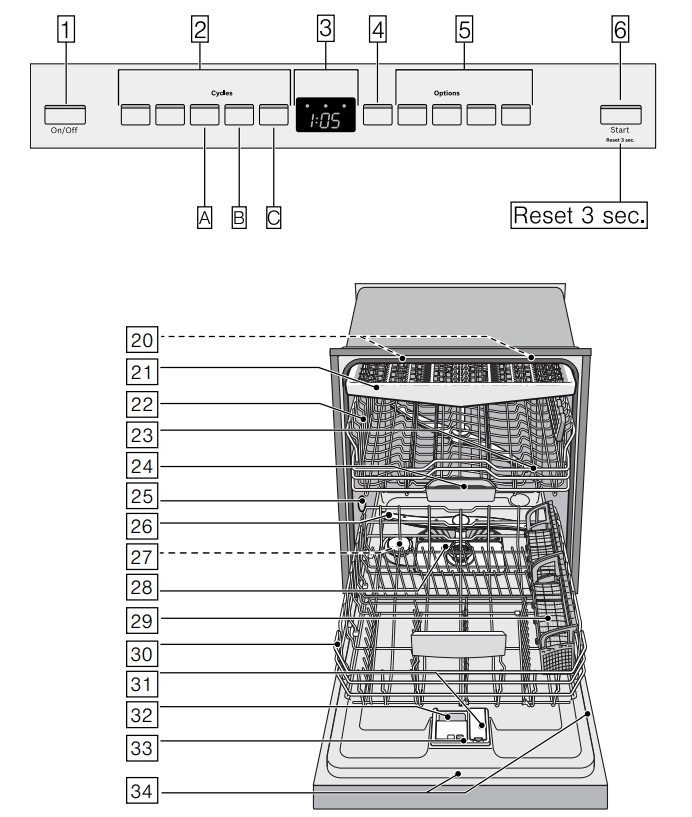
The dotted lines show optional features which may or may not be included with your dishwasher
Operating panel
1. On/Off button
2.Wash cycles
3. Digital display
4. Delay start button
5. Wash cycle options
6. Start button
Dishwasher interior components
20. Interior light
21. Third rack
22. Upper rack
23. Upper spray arm
24. Detergent tab tray
25. Vent hole
26. Lower spray arm
27. Dispenser for special salt*
28. Filters
29. Silverware basket
30. Lower rack
31. Rinse aid dispenser
32. Detergent dispenser
33. Lock for detergent dispenser
34. Rating plate
* optional feature which may or may not be included with your dishwasher.
Display indicators

Menu overview
- The dishwasher has been preset with certain settings for your convenience. You can change these factory settings
- Use the function keys A, B and C to change the settings.
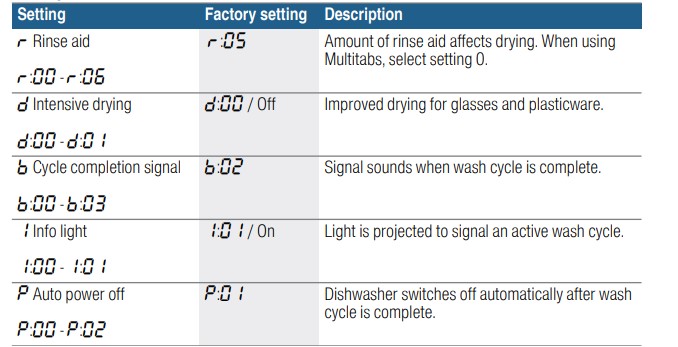
Loading the Dishwasher
Loading the racks
For best dishwashing results, observe the following when loading the dishwasher:
- Do not pre-wash items with loosely attached food soil.
- Remove all food particles, bones, toothpicks and excessive grease.
- Pre-treat items having burned-on, baked-on or starchy soils.
- Load dishes in the dishwasher racks so the insides of bowls, pots and pans are facing the spray arms.
- Avoid nesting and contact points between dishes.
- Separate items of dissimilar metals. Use care to not block movement of the spray arms.
- Only wash household dishware and kitchenware rated as dishwasher-safe. Refer to the Dishware Materials section for more information about dishware suitability
Loading the silverware basket
Place knives and sharp utensils with their handles up and forks and spoons with their handles down. If large or oddly-shaped items are loaded in the silverware basket, be sure they do not nest together.
The Double Flex silverware basket
- This basket splits along its length, resulting in two halves that may be placed in a variety of positions in the lower rack 30, greatly increasing the lower rack’s loading versatility. The basket snaps together either side by side or back to back
- To split the Double Flex silverware basket: Grasp the basket and slide the two halves in opposite directions and then pull the two halves apart.
Side by side

Back to back
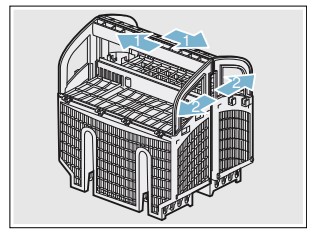
- To assemble the Double Flex silverware basket: Hold the two halves side by side or back to back, so that the tab on one basket can slip into the notch on the other basket. Push the two halves in opposite directions until they click.
Note: The silverware basket lid may also be folded downward in order to leave the basket open.
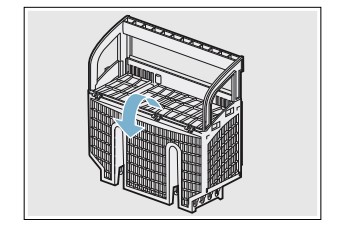
- This dishwasher is equipped with a silverware drawer that should accommodate most silverware loading needs.
- However, if you are washing while the silverware drawer has been removed, or with excess silverware, a silverware basket is also included.
- When loading the silverware basket you should avoid excessive contact points and nesting of similar items (allowing two spons to rest inside one another).
- A good way to avoid excessive contact points is to load the silverware basket with the lids closed, inserting each piece of silverware into one of the individual slots as shown.
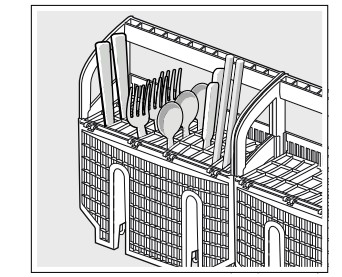
Detergent
- Use only detergent specifically designed for dishwashers. For best results, use fresh powdered dishwashing detergent or detergent tabs.
- This dishwasher uses less water than most, therefore, less detergent is required. With soft water, 1 tablespoon (15 ml) of detergent will clean most loads. The detergent dispenser cup has lines that measure detergent to 1 tablespoon (15 ml) and 1.75 tablespoons (25 ml). 3 tablespoons (45 ml) of detergent will completely fill the detergent dispenser.
Note: If you do not know the hardness of your water supply, use 15 ml of detergent. Increase the amount if necessary to the least amount required to get your kitchenware clean.
Use the measuring lines in the detergent dispenser cup as a guide to measure the amount of detergent recommended in the following table.
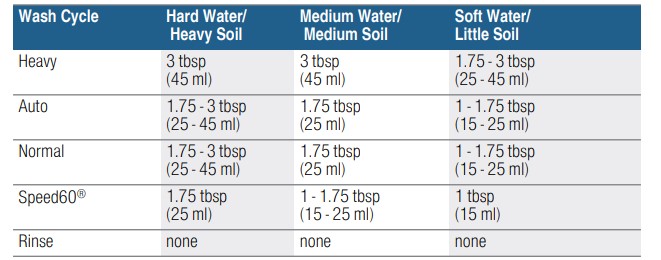
Adding detergent
- If the detergent dispenser 32 is still closed, actuate the locking bar 33 to open it.

- Pour detergent into the dry detergent dispenser 32 only. Add detergent. Do not overfill the detergent dispenser. When using detergent tabs, lay them such that they do not come in contact with the cover, insert a detergent tab flat, not on its side.
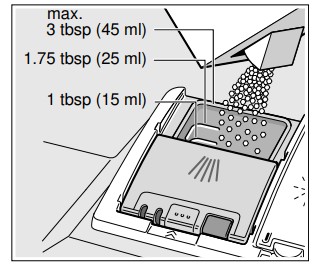
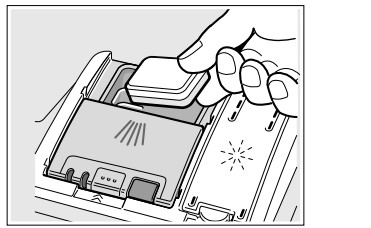
- Close the lid by placing the finger on the lid as shown. Slide the lid closed and press down firmly until it clicks.

The detergent dispenser will open automatically at the ideal time for the set cycle. The powder or liquid detergent is distributed in the appliance and is dissolved, detergent tabs will fall into the detergent tab tray 24 where it dissolves during the cycle.
Tip: If the dishware is only lightly soiled, slightly less than the indicated amount of detergent is usually adequate.
Dishwasher Cycle Options
Delay
- Allows you to delay the start time of your dishwasher up to 24 hours.
Half Load
- Can reduce water consumption when washing small, lightly soiled loads that fill approximately half of the dishwasher’s capacity
Sanitize
- Increases the temperatures and retains them for an extra long time to obtain a defined disinfecting performance. Continuous use of this function increases the hygiene status. This additional option is ideal for cleaning items such as chopping boards and baby bottles.
- Using the Sanitize option may also improve drying. The cycle time and energy usage may be increased.
Extra Dry
- Used in combination with a wash cycle (except Rinse), the Extra Dry option raises the temperature and extends the drying time to further enhance drying results and provide a brilliant shine. The energy usage may be increased.
ExtraScrub
- This option increases pressure and temperature in the lower rack for intensive cleaning.
Wash Cycle Information
- To save energy, this dishwasher has EcoSense where the sensors in the dishwasher automatically adjust the cycle length, temperature and water changes based on the amount of food soil and the incoming water temperature. The “Smart Control” makes decisions that can cause the cycle time and water usage to adjust intermittently. Wash cycle times are based on 120°F (49° C) water supply. If your household water supply is different than 120°F (49° C), your dishwasher’s cycle times may be impacted

Note: Only sanitizing cycles have been designed to meet the requirements of Section 6 of the NSF/ANSI Standard for Residential Equipment for soil removal and sanitization efficacy. There is no intention, either directly or indirectly, to imply that all cycles have passed sanitization performance tests.
Operating the Dishwasher
Protection against unintentional operation
Your dishwasher is equipped with a function that helps to prevent unintentional operation (e.g. by children).
After setting the dishwasher, the dishwasher door has to be closed within 4 seconds, otherwise the operation will be paused. There will be a signal on the control panel advising you to press the Start button again and close the door.
This function will be activated when:
- pressing Start to begin a wash cycle
- setting Delay time and pressing Start
- opening the door while Delay time is active
- opening the door during a wash cycle.
Note: This function cannot be deactivated.
AquaSensor
- The AquaSensor is an optical measuring device which measures the cleanliness of the rinse water.
- The AquaSensor is used according to the wash cycle. If the AquaSensor is active, “clean” rinse water can be transferred to the next rinse and water consumption can be reduced by 0.8–1-5 gal (3–6 liters). If the rinse water is not yet clear, the water is drained and is replaced with fresh water. In the automatic wash cycles the temperature and running time can also be adjusted to the degree of soiling.
Switching the appliance on
- Turn the water supply on fully.
- Press the On/Off button 1. The AUTO wash cycle has been preset as a default whenever the appliance starts. This wash cycle remains selected if no other wash cycle button 2 is pressed. Select any desired option.
- Press Start button 6
Wash cycle sequence starts.
Note: Your dishwasher is protected against unintentional operation. If the appliance door remains open for more than 4 seconds after pressing the Start button, the operation will be paused. Close the appliance door and press the Start button 6 again.
Time display
- When a wash cycle is selected the remaining wash cycle time is shown on the display 3.
- The wash cycle time is determined during the wash cycle by the water temperature, the amount of dishes, as well as the degree of soiling and may vary (depending on the selected wash cycle).
Switching off the appliance
Short time after the end of the wash cycle:
- Open the door.
- Switch off On/Off button 1.
- Turn off water supply.
- . Remove the utensils when they have cooled down.
Interrupting the wash cycle
CAUTION: Expansion (overpressure) may cause the appliance door to open and/or water to escape! If the door was opened on an appliance which has a hot water connection or is heated, always leave the door ajar for several minutes and then close.
- Open the door.
- Switch off On/Off switch 1. The LED’s go out. The wash cycle is saved.
- To continue the wash cycle, switch on the On/Off switch 1 again.
- Close the door
Note: Your dishwasher is protected against unintentional operation. If the appliance door remains open for more than 4 seconds after pressing the Start button, the operation will be paused. Press the Start button again and close the appliance door.
Care and Maintenance
Overall condition of the dishwasher
NOTICE
- Never use a steam cleaner to clean your dishwasher. The manufacturer is not liable for any resulting damage.
- Regularly wipe the front of the appliance with a damp cloth - water and a small amount of liquid soap is adequate. Do not use sponges as they could scratch the surfaces.
- Do not use bleach-based wipes as they could damage the surface or printing.
- Stainless steel appliances: To prevent corrosion, do not use sponges or chlorine based cleaners. Use a stainless steel polish to seal and protect the surface. Do not use chlorine based cleaners or wipes.
- Clean the outer edges of the inside door panel regularly to remove debris that may collect from normal loading. If spots begin to appear on the stainless steel, make sure the rinse agent is full and functioning properly.
- Clean the door seal regularly with a damp cloth to remove food particles that may collect from normal loading and cause odor. A soiled door seal may not seal properly.
Filters
- The Bosch® filter system 28 is designed to prevent the need to pre-rinse normally attached food soils from your dishes. Simply scrape leftover food soils off of dishware before loading. This process will conserve time, water and the energy require to heat your household water supply.
- Your dishwasher filter system is designed to filter 100% of the water entering the spray arms to provide a continuous supply of clean water to remove food soils from your dishware.
Filter components
The filter system 28 consists of three parts.
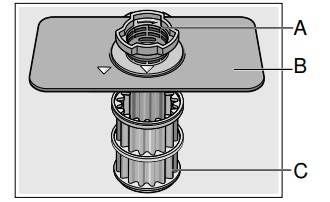
A Large Object Trap
- Prevents objects that should not be placed in your dishwasher from damaging the dishwasher pump system or clogging your household drain.
B Flat Fine Filter
- Prevents food particles from entering the wash chamber and directs particles toward the micro filter.
C Micro Filter
- Directs the smallest of particles to the household plumbing drain.
Cleaning intervals
The filter system 28 is designed to minimize maintenance while providing premium cleaning performance and minimum energy consumption
Depending on use habits and water hardness, the filter system will require some maintenance to sustain premium cleaning performance.
Your filter system may need to be cleaned when:
- You notice food soils remaining on the filter system or objects trapped in the Large Object Trap.
- A drop in cleaning performance or a gritty film forms on the dishware.
To check or clean the filter system:
- Unscrew the Large Object Trap as illustrated and remove the entire filter system.
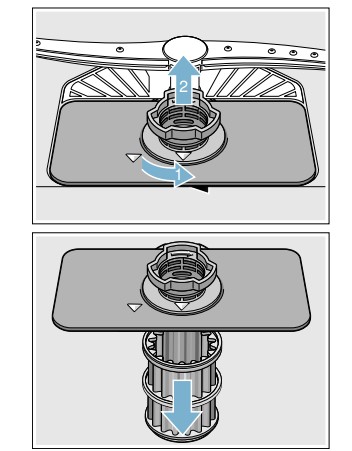
- Remove any residue and clean filters by rinsing under running water. Note: do not use abrasive brushes or steel wool, etc., as they may damage the filter.
- Reinstall the filter system in reverse sequence and lock into place by screwing the Large Object Trap until the marking arrows align.
Troubleshooting
Dishwasher does not start
- Door may not be properly latched.
- Shut the door completely until you hear a click.
- Dishwasher may not be turned on.
- Press the main power switch 1 to turn dishwasher on.
- Dishwasher not reset or previous cycle not completed.
- Reset the dishwasher.
- Delay start engaged.
- Reset Delay start.
- Interruption of electrical power supply to dishwasher or blown fuse.
- Check circuit breaker.
- The door may have been closed without first selecting a cycle.
- Select a cycle and close the door.
- Water supply may not be turned on.
- Check and turn on water supply.
Cycle does not resume after door is opened and closed during cycle
- Door is opened longer than 4 seconds after a cycle has started.
- Press Start button again to resume cycle.
Display does not illuminate
- A fuse may have been blown or circuit breaker tripped.
- Check the fuse or circuit breaker box and replace the fuse or reset the breaker if necessary
- Door not closed or latched. Note: For models with controls on top of the door, the display only illuminates when the door is opened and controls are visible.
- Ensure door is properly latched and completely closed.
Dishwasher seems to run a long time
- Incoming water is not warm enough.
- Before starting a cycle, run hot water faucet at the sink closest to the dishwasher
- Cycle time can vary due to soil and water conditions.
- Sensors in the dishwasher automatically increase the cycle time to ensure a good wash when heavy soil is detected
- Rinse aid dispenser 31 is empty, or rinse aid setting has been set to “0”.
- Add rinse aid, or change rinse aid setting.
- Dishwasher connected to cold water supply.
- Verify dishwasher is connected to hot water supply plumbing.
Dishes are not getting clean enough
- Spray arm movement obstructed.
- Ensure that spray arm movement is not blocked by hand rotating spray arms 23, 26 before starting cycle.
- Spray arm nozzles clogged.
- Remove spray arms 23, 26 and clean them
- Improper use of detergents.
- Increase or decrease detergent depending on the water hardness
- Filters 28 could be clogged.
- Clean the filters 28
- Dishes are nested or loaded too closely together.
- Rearrange load such that water spray can reach all items in the dishwasher.
- Selected wash cycle is not suitable for food soil conditions.
- Refer to Wash Cycle Information
Streaks on glassware or residue on the dishes
- Incorrect rinse aid setting.
- Depending on the hardness of water, adjust the rinse agent dispenser 31
Dishes are not getting dry enough Note: Plastic or Teflon do not typically dry as well as other items due to their inherent properties.
- Rinse aid dispenser 31 is empty or incorrect rinse aid amount is set.
- Add rinse aid or adjust setting - the use of rinse agent improves drying, use the Auto cycle, use the Sanitize option.
- Improper loading of dishes.
- Rearrange load to ensure items are not nesting
Odor. Note: Water testing is done in the factory. Occasionally water may still appear in dishwasher at purchase which may create an odor.
- Food debris is present at the bottom of the dishwasher.
- Remove the filters and clean them
- Food particles are present near the door seal.
- "Care and Maintenance"
- Residual water is present at the bottom of the dishwasher.
- Ensure the dishwasher has completely drained from the last cycle
- Drain hose is obstructed.
- Remove any obstructions from the drain hose by calling qualified personnel.
- Note: If odor still persists, run the Normal/ Regular cycle until it flushes and interrupt the cycle and place an 8 oz. cup of distilled white vinegar solution on the upper rack and then finish the cycle.
Dishwasher not filling with water or “Check water supply” display lights up
- Restriction in the water supply system.
- Ensure that the water supply valve (typically located under kitchen sink) is open and check that the water supply line has no kinks or clogs.
- Previous wash cycle was not completed.
- "Operating the Dishwasher"
- Delay start is active.
- Cancel the delay start or wait until delay start time completes.
- Household water supply turned off.
- Turn on water supply.
Fascia panel discolored or marked
- Abrasive cleaner used.
- Use mild detergents with soft damp cloth.
Noise during wash cycle
- Dishes may not be arranged properly.
- Water circulation sound is normal, but if you suspect items are banging into each other or into the spray arms, check optimal arrangement of dishes
Water leaks
- Suds.
- Using wrong type of detergent or overfilling the rinse aid dispenser results in suds and leaks - use only dishwasher detergents. If suds still persist, add one tablespoon of vegetable oil at the bottom of the dishwasher and run the desired cycle.
- Door seal could be pulled away from track.
- Ensure the door seal is in the track.
- Condensation vent is blocked.
- Ensure that condensation vent is not blocked.
- Improper installation.
- Have proper installation verified by qualified personnel (water supply, drain system, leveling, plumbing).
Tub stains
- Stains on the dishwasher interior are due to water hardness.
- Concentrated lemon juice can reduce the build-up of hard water stains. Run Normal/Regular cycle until it flushes and interrupt the cycle and then place an 8 oz. cup of the concentrated lemon solution on the upper rack and finish the cycle. This can be done periodically to avoid build-up.
- Silverware in contact with tub.
- Ensure that silverware does not make contact with the tub while running a cycle.
Detergent dispenser cover will not shut
- Improper operation of detergent cover.
- For instructions on opening and closing the dispenser
- Previous cycle was not finished or interrupted.
- "Operating the Dishwasher"
Unable to select desired cycle
- Previous cycle not finished.
- "Operating the Dishwasher"
See other models: SHP865WF2N SHS63VL6UC SHP865WD5N SGE53X55UC SHEM3AY56N
